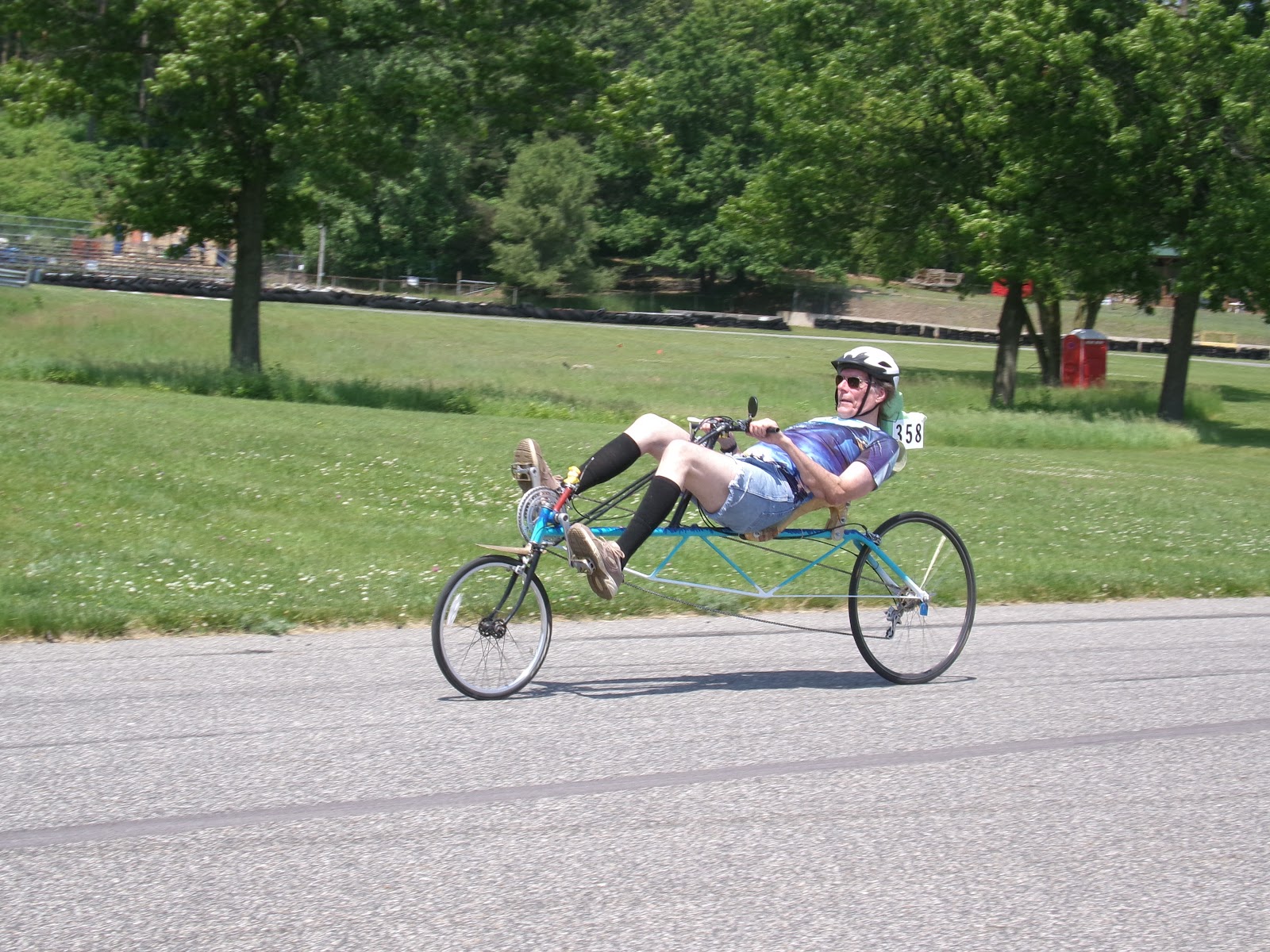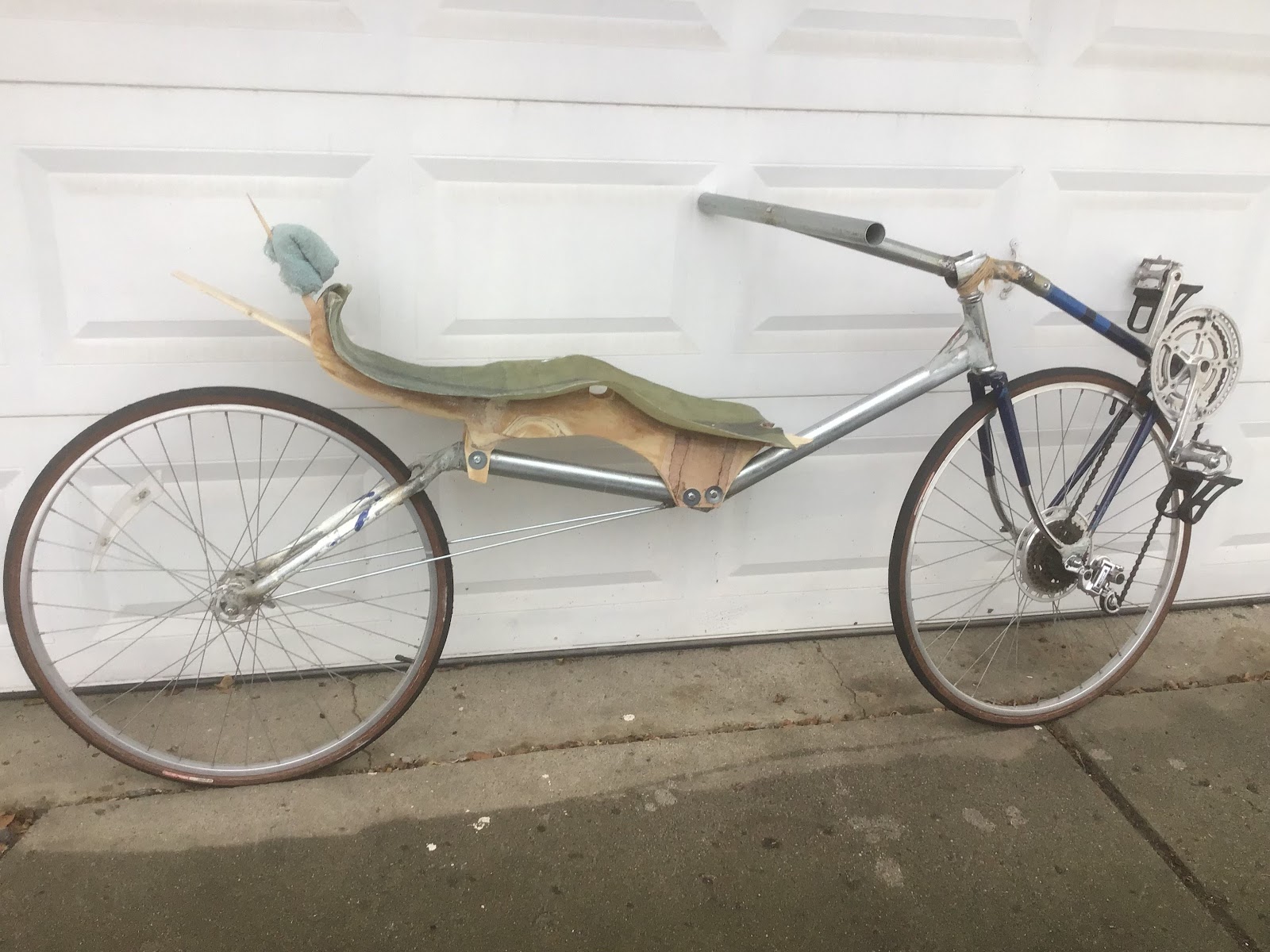
Last year’s bike seemed to be taking things a little too leisurely, so I resolved that this year’s bike should pick up the pace a little.
I have an artist friend who says, “A painting is never really finished- you just hit a point where you give up on it”, and in that sense, that's what happened with my 2025 racing bike.
The goal for this year was to work on a more aerodynamic rider position. Indeed, I started out flat on my back, which didn’t work.
The first attempt was a front-wheel-drive monster, whose steering proved so intractable it was aborted after a few test rides.
Charles’ attempt at a front-wheel-drive.
Then this spring I tried again, with a rear-wheel-drive design (above),
I don’t think I’ve ever built a bike that had more teething problems. I’ve chopped up and rebuilt this thing a number of times. Even so, on what I euphemistically term my “training rides” along local side streets, hills were surmounted with a mighty tugging on the handlebars – not very efficient, and its progress down said streets can best be described as “stately”.
Prior to the rally, I could only hope my rolling track obstruction trundled along a little better than last year. I’ve been able to learn a lot about rider position, although more about what doesn’t work than what does!
To this end, I designed it with the rider (me) completely flat on my back for minimum air drag. My torso was secured in place by an extreme lumbar support, a belt to strap me in, shoulder hooks, and (planned) clipless pedals.
Test rides proved disappointing, and constant butchering and rebuilding continued up to race day. At least I learned some new things.
It was great to see old friends at the rally, even Jay Hoover, who I used to bike with in Florida!
The innovation award goes to a guy from Canada (Ray Mickevicius of Wasaga Beach, Ontario) who brought two Pedal Prix racers, designed in Australia. These are the smallest faired tricycles I have ever seen. Instead of the rider’s head sticking up in a bubble, the rider lies very, very flat, with no head bulge. There’s a row of windows around the craft so you can see out.
He was generously letting a long queue of people ride them. Visibility seemed okay. It’s a bit of a greenhouse, even with the opaque top, but you could use infared blocking window film, and the windows could be smaller.
I’d rather use a velomobile for commuting, but this design has the potential to beat them on the track.
John Simon and I realized we both started coming to Waterford in 1987. He had a bit of a slump the last few years, but he was kicking ass and taking names this weekend. He said the only change he made to his Moby streamliner was to install Vittoria ‘graphene’ tires. I looked it up on ‘www.bicyclerollingresistance.com’ and ‘Vittoria Corsa Pro Speed TLR 28’ had the lowest rolling resistance of anything on the list. He might be on to something.
Back to my bike, in my own testing, I found the best steering with narrow handlebars at 0-6 inches of “tiller” (the distance from handlebars to the steering axis) and a little more with wider bars. In contrast, Dennis Grelk prefers 1 to 1-1/2 feet, and feels uncomfortable with anything less! Why the discrepancy?
It would be neat to have a way of testing rider power at the races.
In 1986, I was riding a long-wheelbase low racer in traffic when I almost became a much lower racer.
Since then, I’ve built my bikes with the rider’s head high enough to see and be seen in traffic. This creates more air drag than low racers, and I can’t compete. I’d like it if those building practical vehicles could put an ‘R’ after their vehicle number, for "roadworthy." After the races, we could compare and see how we did against the other real world vehicles.
I’d like to see more development of partial fairings. If it doesn’t make it hard to get on and off the bike or get knocked around by the wind, why not?
There was a time when upright riders thought we were cheating. It’s not cheating, it’s using our mind as well as our bodies!
Testing to see how hard I could press the scale with my seat at different angles. I learned that static tests do not correlate well with power when pedaling.







No comments:
Post a Comment